
Inca lily, alstroemeria: to plant, to grow, to maintain
Contents
The Inca lily, in a nutshell
- Alstroemerias or Peruvian Lilies are summer perennials with an exotic appearance, highly floriferous, that splendidly replace border plants
- They feature numerous varieties with large trumpet-shaped flowers in a variety of attractive colours reminiscent of a myriad of butterflies
- Their exceptional flowering will delight you, whether on the balcony or in borders
- They require a sunny or partially shaded, warm location, and fresh, rich, well-drained soil
- The flowers are valued for their good vase life and spectacular colours
A word from our expert
Alstroemeria, or Peruvian Lily, has been increasingly popular in gardens and pots over the past few years, making it one of the most sold summer flowers. Its very long flowering period with exotic accents lasts from late May until October-November. While most varieties are planted in flowering pots, many grow easily in our gardens and are very easy to cultivate in loose, rich soil, kept moist throughout the summer. Avoid overly dry and sunny spots exposed to wind. In slightly harsh climates, you can bring the pot indoors during winter. When repotting or transplanting, be careful not to disturb the roots too much, as they can be brittle, especially in young plants.
Cut flowers are available year-round and have won the hearts of florists, who now have a wide range of colours: white, red, pink, salmon, orange, yellow, mauve… They can create bouquets on their own but also pair successfully with other flowers. The flowering lasts 2 to 3 weeks without fading! To optimise the longevity of your alstroemerias in bouquets, change the water every 2 or 3 days and remove wilted flowers and their stems as needed.
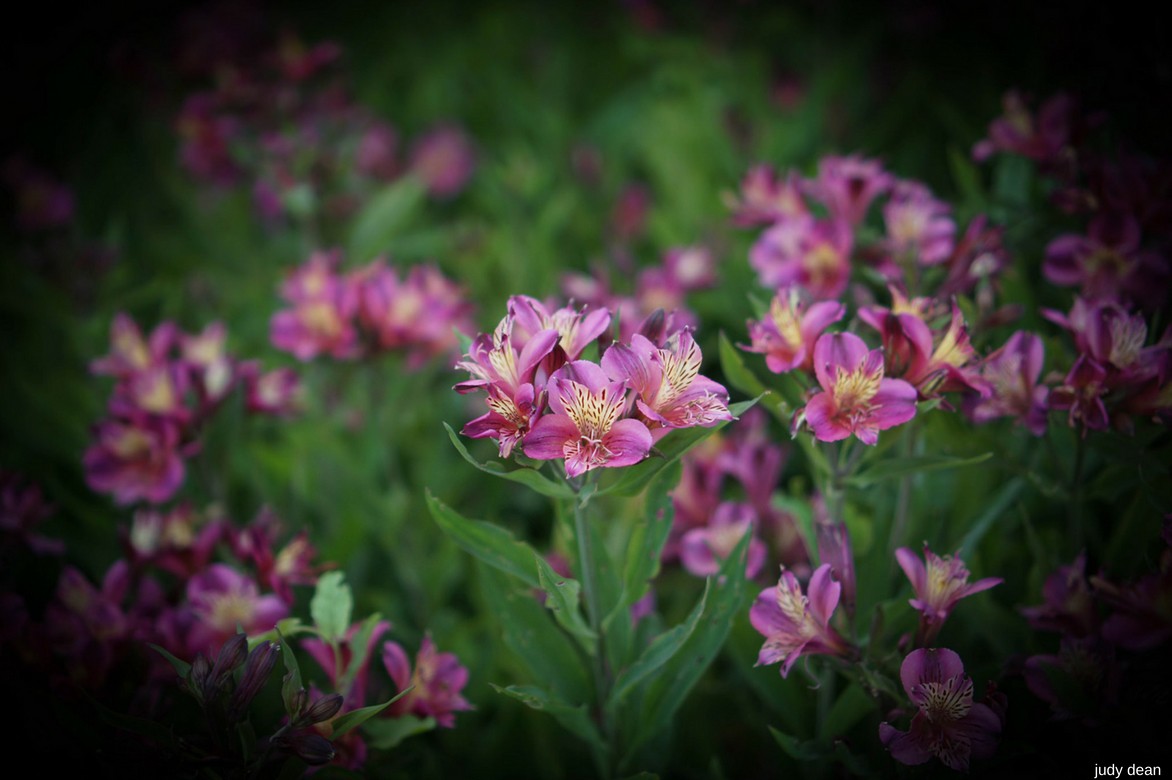
Exotic charm of Peruvian Lilies.
Description and Botany
Botanical data
- Latin name Alstroemeria
- Family Alstroemeriaceae
- Common name alstroemeria
- Flowering from June to October
- Height between 30 cm and 1 m
- Exposure sun, partial shade
- Soil type acidic or neutral, humus-bearing, cool and well-drained
- Hardiness fairly good
The Alstroemeria, commonly known as lily of the Incas or Peruvian lily, belongs to the family Alstroemeriaceae (formerly Liliaceae or Amaryllidaceae) and comprises around fifty species, all native to South America, primarily the Andes. All plants in this genus are perennials with tuberous and rhizomatous roots. The hardiest species are native to the Chilean Andes and Patagonia, such as Alstroemeria aurea (syn. aurantiaca), which can tolerate temperatures as low as -16°C and is found in humid wooded areas at altitude. It prefers cool but not waterlogged soils in our colder climates. The species A. ligtu, with pink flowers and resistant to -15°C, grows in dry thickets on sandy or rocky soils in Chile, as does A. haemantha, found in the Valparaiso region, which can withstand frosts down to -10°C.
These last two species have been the subject of hybridization following the visit to Chile by British horticulturist Clarence Elliott (1881-1969) in 1927. The Dutch company Van Straaveren B. V. from Aalsmeer became interested in producing cultivars for cut flowers, which also make excellent garden plants with a hardiness of -10°C. Recent cultivars are often more compact, measuring 50 to 80 cm in all directions, resulting from cross-breeding with A. aurea and are triploid. They are sterile and therefore do not produce fruit, which facilitates the continuation of flowering. These cultivars are more reliable and more resistant to our wet and cold winters.
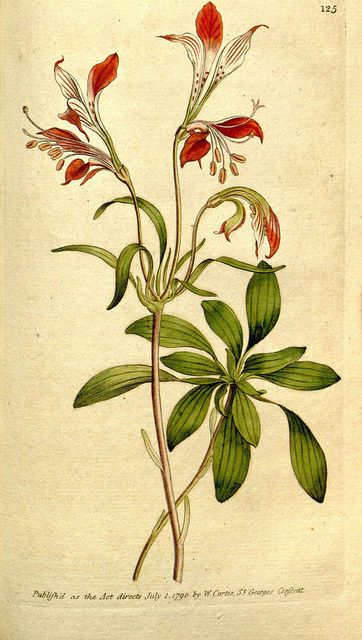
Alstroemeria – botanical illustration
The clump of alstroemeria produces upright stems reaching heights of 30 cm to 1 m, adorned with alternate, ribbon-like or lanceolate leaves measuring 10 to 12 cm long, ranging from glossy green to grey-green, and sometimes even bronze with purple highlights. It spreads quite rapidly due to its fine, brittle tuberous roots, sometimes becoming invasive. The petioles connecting the lamina to the stem are uniquely curled, giving the foliage a frizzy appearance. From June onwards, and often until the frosts for hybrids, generous umbels of striped and spotted flowers crown the sturdy stems. The clump completely disappears at the first frost, making it difficult to spot before it emerges in spring.
The flowers, measuring 4 to 10 cm long, can be tubular as seen in the botanical species A. psittacea or have an open trumpet-shaped corolla. The bilaterally symmetrical flowers feature 6 tepals (3 petals and 3 similar sepals) with variations in colour. The petals, which are slightly narrower than the sepals, often display large bright yellow areas striped with brown, designed to attract pollinating insects. The flower has 6 curved stamens and 1 pistil. Some are even fragrant, such as the Brazilian species Alstroemeria caryophyllacea, which emits a surprising clove-like scent passed on to its hybrids like ‘Sweet Laura’.

Inflorescences in various colours: Alstroemeria ‘Mars’, Alstroemeria ‘Sweet Laura’, Alstroemeria inticancha ‘Indian Summer’, Alstroemeria inticancha ‘Sunday’, Alstroemeria ‘Majesty’.
The main varieties
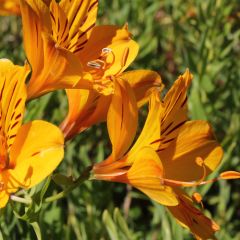
Alstroemeria aurantiaca
- Flowering time August to October
- Height at maturity 80 cm
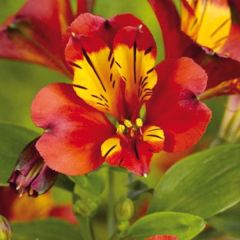
Alstroemère - Alstroemeria Inca Pulse
- Flowering time July to November
- Height at maturity 50 cm
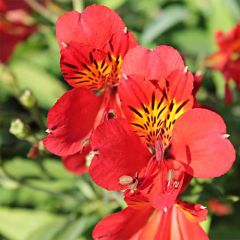
Alstroemeria Mars
- Flowering time July to October
- Height at maturity 80 cm
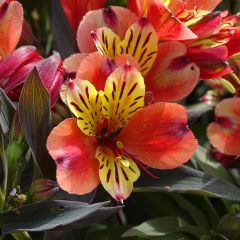
Alstroemeria Indian Summer
- Flowering time July to November
- Height at maturity 70 cm
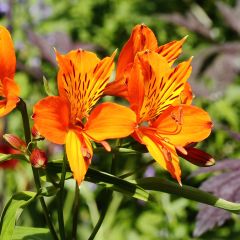
Alstroemeria aurantiaca Orange King
- Flowering time August, September
- Height at maturity 80 cm
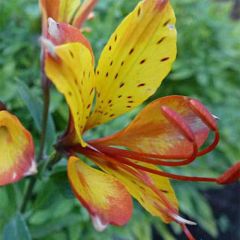
Alstroemeria Sweet Laura
- Flowering time July to October
- Height at maturity 70 cm
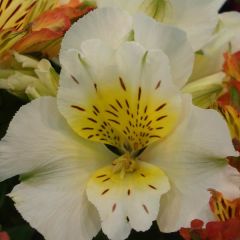
Alstroemeria Inticancha Cabana - Peruvian Lily
- Flowering time July to November
- Height at maturity 35 cm
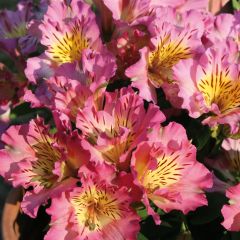
Alstroemeria Inticancha Sunday
- Flowering time July to November
- Height at maturity 60 cm
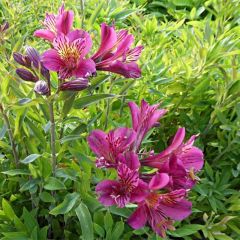
Alstroemeria Mauve Majesty
- Flowering time July to October
- Height at maturity 65 cm
Discover other Alstroemerias
View all →Available in 1 sizes
Available in 1 sizes
Available in 1 sizes
Available in 0 sizes
Available in 1 sizes
Available in 1 sizes
Available in 1 sizes
Available in 1 sizes
Available in 1 sizes
Available in 1 sizes
Planting Inca lilies
Where to plant?
Inca lilies appreciate a location benefiting from morning sun, or partial shade under the light foliage of a tree with light leaves like that of the Albizia.
They require light, well-drained, well-worked soil, sandy or loamy with low lime content, neutral to slightly acidic. The coolness of the soil helps support flowering, but they adapt quite well to drier soils in summer. They can easily colonise a clear understorey or a bank.
These plants are quite hardy as long as the soil does not remain waterlogged in winter. In cold regions, the stump can be protected with a thick mulch of leaves, dry turf, or fern fronds, applied in autumn. Slugs and snails love the young shoots, which need protection if you want to keep the plant.
As the plant completely disappears in autumn, it is advisable to mark its location. Do not disturb the clump with a hoe: the tuberised roots are often wandering and fragile. Weeding should be done by hand with care.
Choose the location carefully, as once established, alstroemerias do not like to be moved!
When to plant?
Plant alstroemerias in spring, between March and May, or even early summer if you buy a potted plant. Avoid disturbing the roots during flowering. Note that young plants sold in buckets take 2 to 3 years to form a lush clump, except for the new hybrids.
How to plant?
To plant your alstroemerias:
- Space the plants 40 to 50 cm apart.
- Moisten the root ball to facilitate recovery.
- Dig a planting hole, two to three times the size of the root ball. Add a bit of decomposed compost or organic fertiliser.
- Place the plant in the hole slightly below soil level to provide more coolness to the roots.
- Ensure the roots from the rootstock are placed vertically. Trim them if necessary.
- Replace the soil and lightly firm it down.
- Water.
- Spread a layer of mulch to maintain good coolness around the roots. This will also limit the growth of weeds.
For a pot culture, place a draining layer of 3-4 cm at the bottom of the pot (gravel, broken pottery, etc.). Add a mixture of potting soil and non-lime garden soil. Also, read our dedicated advice sheet: Succeeding with Alstroemeria in pots,

Close-up of an Inca lily flower.
Read also
How to protect bulbs from rodents?Maintenance and watering
Alstroemerias require regular watering to maintain flowering. Water at least once a week during the warm season to ensure impeccable and abundant flowering.
- Cut faded flowers to encourage regrowth even though most hybrids do not produce fruit.
- Add flowering plant fertiliser, especially to potted plants, to stimulate flowering.
The plant is very resistant to pests and diseases. However, it is regularly attacked by slugs and snails in spring. A layer of fern mulch has a repellent effect on these pests.
Multiplication: division and sowing
You can multiply the alstroemeria by clump division every 5-6 years; this is the simplest method to implement. Sowing is possible when it comes to botanical species; however, this technique does not allow for a high success rate.
Clump Division
Operate in spring during March-April or just after flowering at the end of summer on a subject at least 3 years old.
- Dig up the clump by giving 4 spade strikes of at least 20 cm deep, then gently lift it.
- If necessary, cut the clump with a knife to separate blocks of roots and stems.
- Replant immediately in a hole 20 cm deep, enriched with decomposed manure or organic fertiliser.
- Place the roots coming from the rootstock vertically. Do not hesitate to trim them cleanly if necessary.
- Close the hole and water generously but without excess.
- Mulch with ferns to maintain moisture and deter slugs.
Sowing
Only botanical species such as Alstroemeria aurea or psittacea will give you flowers identical to the mother plant. This operation remains quite delicate for the amateur gardener.
- You can soak the seeds for a few hours in water before sowing them.
- Sow the seeds in spring (around March-April) in a sandy substrate that you place in a well-lit heated greenhouse.
- As soon as the leaves appear, transplant the seedlings into 9 cm buckets filled with turf.
- Wait until the following spring to plant the young plants in the ground or in pots.
Using and Combining Alstroemeria in the Garden
With its orchid-like appearance, the Inca lily makes a statement regardless of its use.
The compact forms lavishly highlight the borders of a bed, a path or illuminate a partially shaded bank covered with Epimedium or Pachysandra. They can be grown as annuals given the exceptional duration of their flowering.
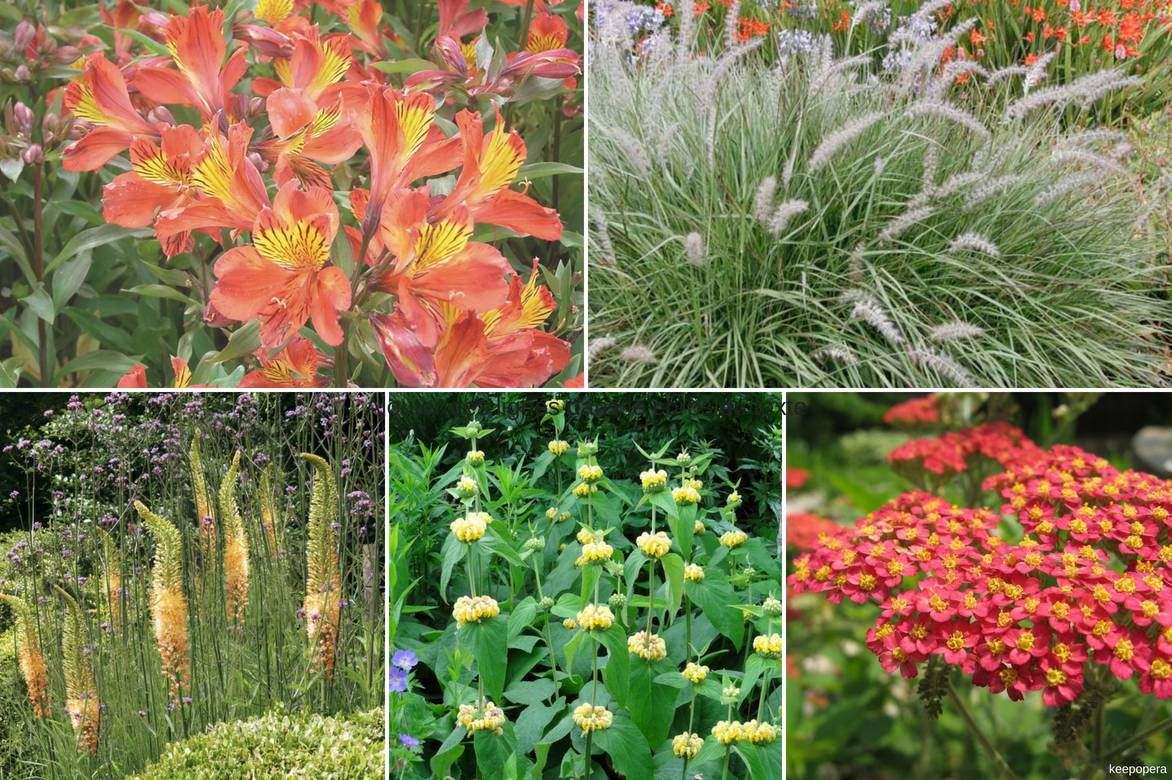
An example of a warm-toned combination: Alstroemeria ‘Inca Tropic’, Pennisetum orientale, Eremurus ‘Cleopatra’, Phlomis russeliana, Achillea millefolium ‘Paprika’.
The tall forms are perfect for filling large mixed-border beds. They pair splendidly with generous plants such as landscape roses, Agapanthus (Golden Drop, Silver Moon), Amaryllis, Crocosmias, Dahlias, Echinaceas, Foxgloves, or even Phlox. To lighten the scene, consider mixing them with the delicate flowers of Fuchsias magellanica, of Gaura, the graphic stems of Verbena bonariensis, or even with grasses (Stipa, Miscanthus dwarf, Muhlenbergia capillaris, etc.). Their sturdy, robust stems are weather-resistant and do not require staking. However, avoid planting them in full wind.
For more combinations, discover our 7 ideas for combining alstroemerias.
Did you know?
- The flower of the alstroemeria is the flower of happiness, symbolising the joy of being together, in friendship as well as in love. Giving a bouquet of Peruvian lilies allows you to convey your wishes for happiness and prosperity!
- The genus Alstroemeria honours the Swedish botanist and naturalist Clauss Alströmer, who sent seeds of A. psittacea to Linnaeus from Spain.
To go further
Discover:
- Our wide range of alstroemerias
- Alstroemeria: 11 perfect dwarf varieties for pots
- Advice sheet: How to protect Inca lilies in winter?
- Discover our selection of the hardiest alstroemerias
- Advice sheet: The best alstroemerias for border planting
- Our advice sheets: 8 white-flowered alstroemerias; 7 yellow-flowered alstroemerias; 12 red-flowered alstroemerias; 7 pink-flowered alstroemerias
- Advice sheet: Alstroemeria, how to choose them well in 3 points?
- Read our advice sheet on The best long-lasting flowers and foliage for your bouquets
- Subscribe!
- Contents
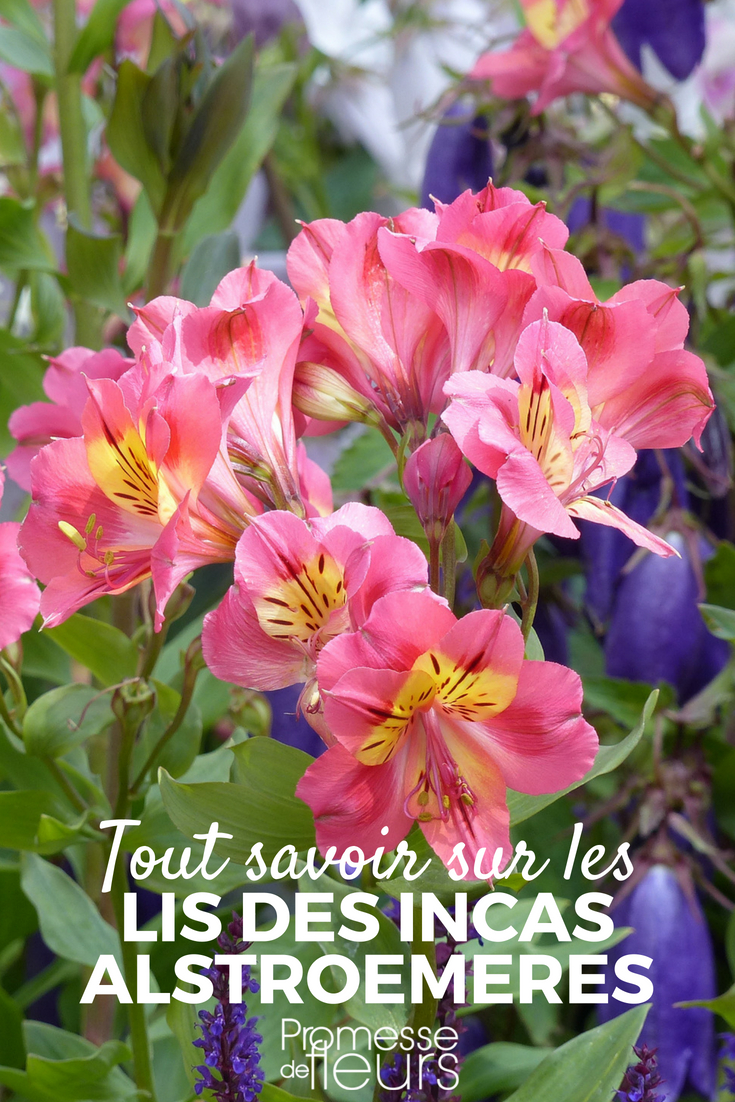































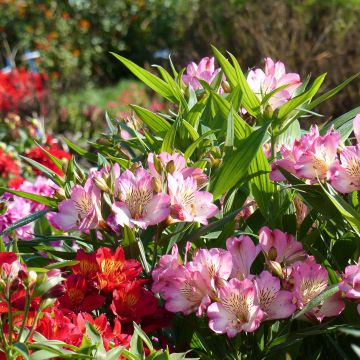
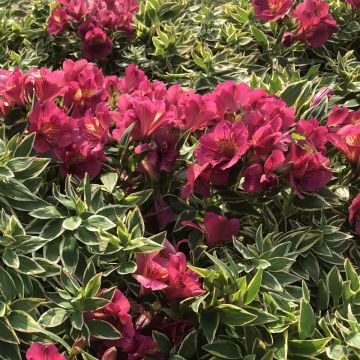
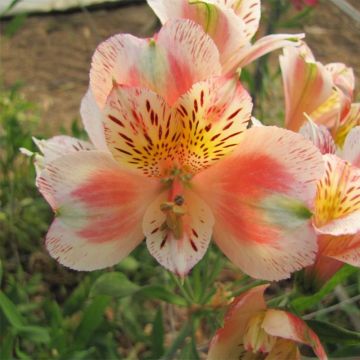
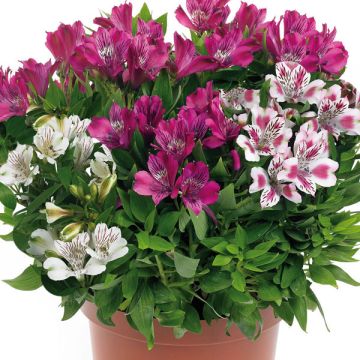

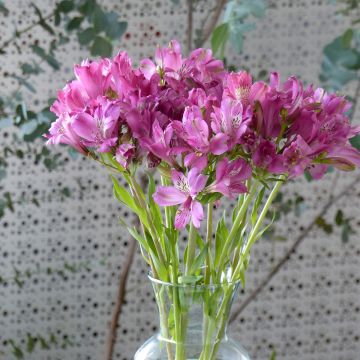
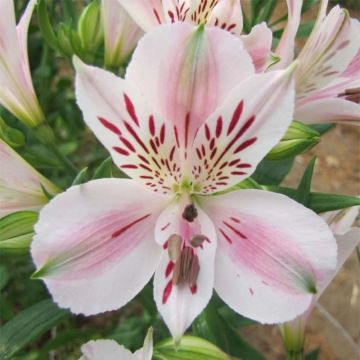
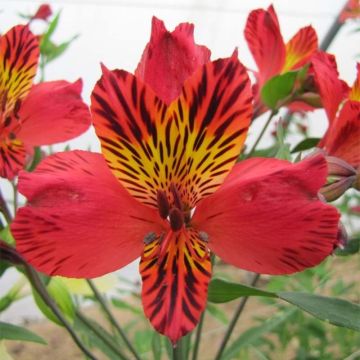
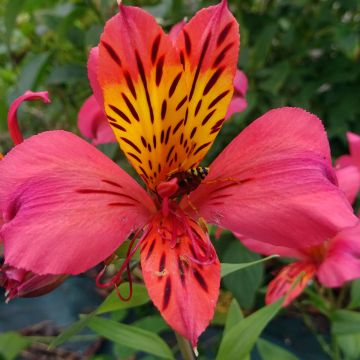
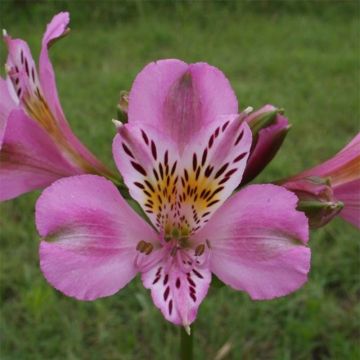
Comments